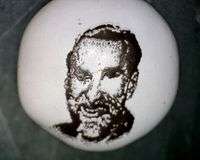Daniel G. Nocera
| Daniel G. Nocera | |
|---|---|
|
Dr. Daniel Nocera as depicted on an M&M candy. Taken at the laboratories of Sun Catalytix Corporation on 15 March 2011 | |
| Born | July 3, 1957 |
| Occupation |
Professor Chemist |
| Website | http://nocera.harvard.edu/ |
Daniel George Nocera (born 3 July 1957) is an American chemist and university professor.[1] His research has focused on the creation of an "artificial leaf" that mimics photosynthesis in plants for use in a decentralized energy system. He is a member of the National Academy of Sciences and the American Academy of Arts and Sciences. Time magazine included him in its 2009 list of the 100 most influential people.[1]
Career
Nocera received a B.S. degree in Chemistry (magna cum laude) from Rutgers University in 1979.[2] He received a Ph.D. degree in Chemistry from the California Institute of Technology in 1984, after working with Professor Harry B. Gray studying the spectroscopy, electrochemistry, and photochemistry of polynuclear metal-metal bonded complexes.[3] He joined the faculty of Michigan State University in 1984 as assistant professor, and became a professor at MSU in 1990. He moved to Massachusetts Institute of Technology as a professor of chemistry in 1997. In February 2012, Nocera agreed to move to the Department of Chemistry and Chemical Biology at Harvard University in Cambridge, MA.
Nocera and his researchers received media attention beginning in 2007 when he declared that a better understanding of the photosynthesis process could lead to economical storage of solar energy as chemical fuel.[4]
He later announced that his group had developed a highly efficient anode electrocatalyst (cobalt phosphate) for use in electrolysis of water employing inexpensive materials.[5][6] His work on artificial photosynthesis centers around the basic mechanisms of energy conversion in biology and chemistry, particularly in the theory of proton coupled electron transfer. He is also the director of the Solar Revolution Project at MIT which seeks to create innovations in photocatalytic water splitting towards the use of solar energy in large scale, mainstream applications.[7]
In October 2010, Nocera signed with the Tata Group of India to commercialize his research.[8]
Awards and honors
- received the American Institute of Chemists Award (1979)
- received the MIT School of Science Prize for Excellence in Undergraduate Teaching (2005)
- received the Eni-Italgas Prize for Energy & the Environment (2005)
- elected to the American Academy of Arts and Sciences (2005)
- received the Inter-American Photochemistry Award in Photochemistry (2006)
- received the first Burghausen Chemistry Award (2007)
- received the American Chemical Society Award in Inorganic Chemistry (2009)[9]
Nocera has published over 225 papers.[10] He has served on scientific advisory boards and editorial boards of several large corporations. He was the inaugural editor of Inorganic Chemistry Communications, and was the inaugural chair of the editorial board for ChemSusChem.
Research areas
Nocera is active in the synthesis, electrochemistry, and spectroscopy of inorganic and organometallic compounds and materials. Themes include
- Synthesis of a S = 1/2 kagome lattice of academic interest in the study of frustrated magnetism, a theme in the field of condensed matter physics.
- Microfluidic optical chemosensors
- Molecular tagging velocimetry (MTV) technique[11]
- Studies of excited states of metal complexes and clusters.[12]
- Hydrogen production from acidic solutions using a rhodium photocatalyst.[13]
- Development of electrocatalysts for oxidation of water.
Publications
- Wishart, James F.; Daniel G. Nocera (1998). Photochemistry and Radiation Chemistry (Advances in Chemistry Series). American Chemical Society. ISBN 978-0-8412-3499-4.
- Nocera has published over 250 scientific papers, which are listed by year on his research group website.
See also
External links
- Nocera at the MIT Chemistry Department Website
- MIT Chemistry Department
- Nocera Group Website
- Daniel Nocera Playlist Appearance on WMBR's Dinnertime Sampler radio show October 6, 2004
- SunCatalytix.com Company website
- PopTech! Dan Nocera: Personalized Energy
- SOLAR ENERGY: CAPTURING THE SUN A 5-day short course Dan Nocera teaches at MIT in August
References
- 1 2 Nair, P. (2012). "Profile of Daniel G. Nocera". Proceedings of the National Academy of Sciences 109 (1): 15–17. doi:10.1073/pnas.1118655109. PMC 3252940. PMID 22219319.
- ↑ Nocera, Daniel George (1983-08-16). "Spectroscopy, electrochemistry, and photochemistry of polynuclear metal-metal bonded complexes" (link to PDF). Caltech. Retrieved 2008-08-03.
- ↑ "CU Energy Initiative/NREL Symposium — Keynote Speakers". University of Colorado at Boulder / National Renewable Energy Laboratory (NREL). 2006-10-03. Archived from the original on 2008-03-12. Retrieved 2008-08-03.
- ↑ Technology Review website, interview conducted 9 May 2007
- ↑ Bullis, Kevin (2008-07-31). "Solar-Power Breakthrough". Technology Review. Massachusetts Institute of Technology. Retrieved 2008-08-03.
- ↑ Kanan, M. W.; Nocera, D. G. (2008). "In Situ Formation of an Oxygen-Evolving Catalyst in Neutral Water Containing Phosphate and Co2+". Science 321 (5892): 1072–1075. doi:10.1126/science.1162018. PMID 18669820.
- ↑ "MIT, Chesonis Foundation announce solar revolution". MIT news office. 2008-04-22. Retrieved 2008-08-03.
- ↑ "Tata signs up MIT energy guru for power from water". Retrieved 2011-03-28.
- ↑ Chemical & Engineering News, 23 February 2009, "2009 ACS National Award Winners", pp. 66-67
- ↑ C&EN/23 Feb. 2009
- ↑ "Molecular Tagging Velocimetry (MTV)". Michigan State University. 2005. Retrieved 2008-08-03.
- ↑ Engebretson, D. S.; Zaleski, J. M.; Leroi, G. E.; Nocera, D. G. (1994). "Direct Spectroscopic Detection of a Zwitterionic Excited State". Science 265 (5173): 759–762. doi:10.1126/science.265.5173.759. PMID 17736272.
- ↑ Heyduk, A. F.; Nocera, D. G. (2001). "Hydrogen Produced from Hydrohalic Acid Solutions by a Two-Electron Mixed-Valence Photocatalyst". Science 293 (5535): 1639–1641. doi:10.1126/science.1062965. PMID 11533485.
|
